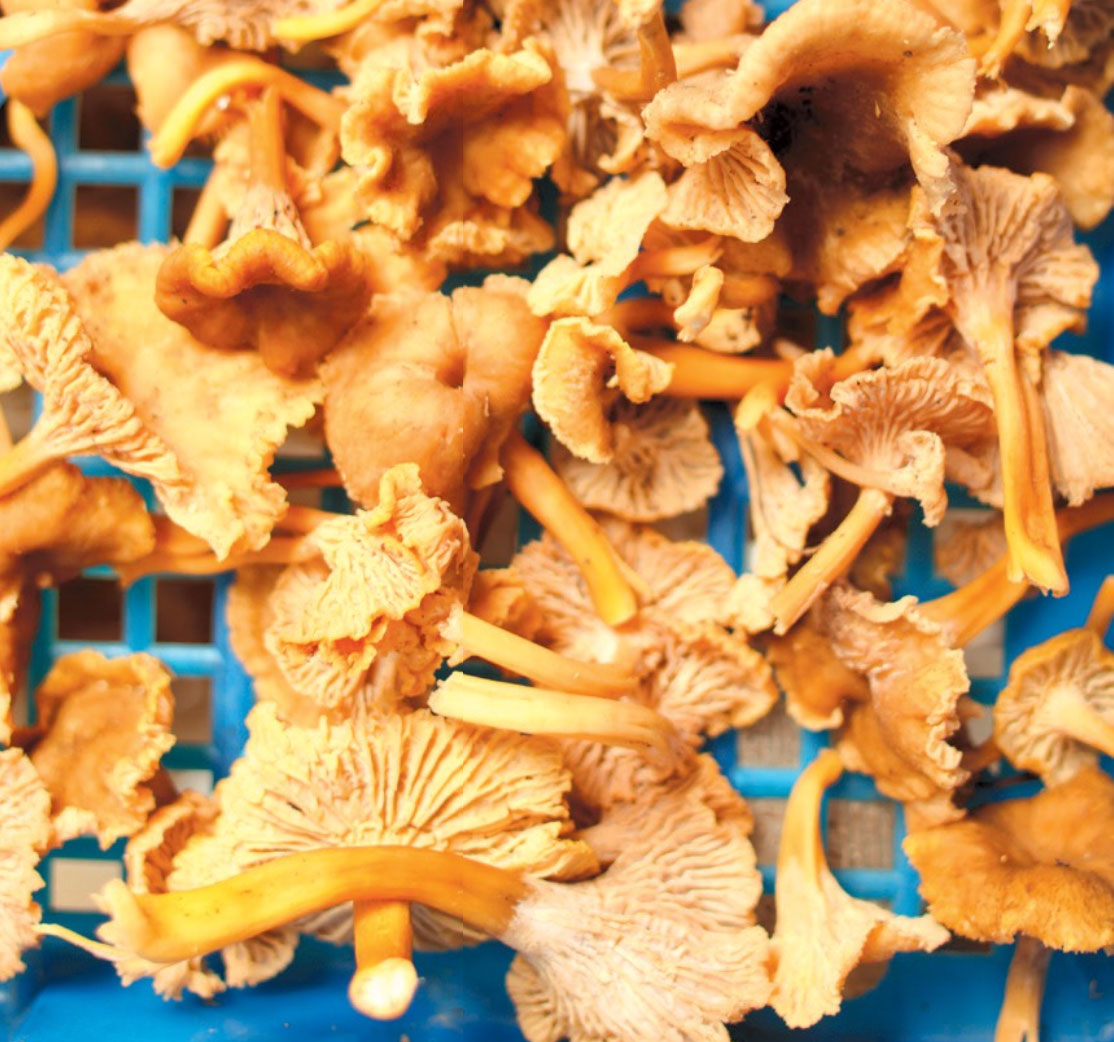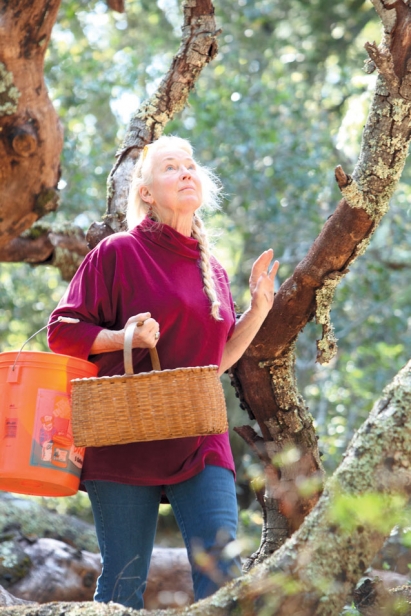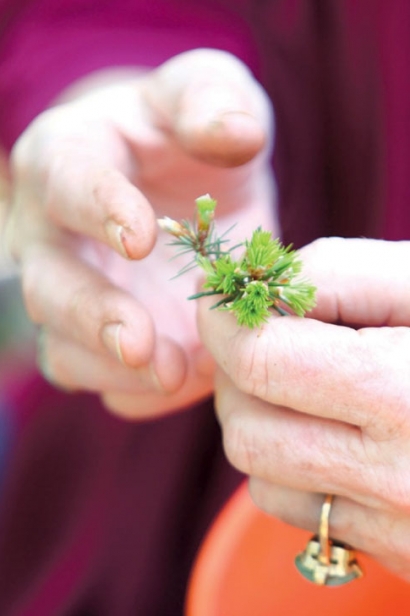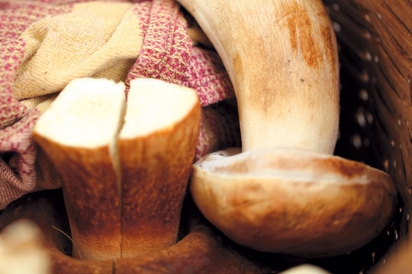The Local Food Forager: Connie Green, Belle of the Southern Wild
It’s a grand thing to have both parents trust you in nature and to learn to look everywhere. As children, when we swam without our parents, they taught us to watch the alligators sunning on the shore when we got in. If the number decreased, we should calmly exit.
—Connie Green, head huntress of Wine Forest Wild Foods
We know the forest round us,
As seamen know the sea;
We know its walks of thorny vines,
Its glades of reedy grass,
Its safe and silent islands
Within the dark morass.
—from Song of Marion’s Men by William Cullen Bryant (1794–1878)
Famed forager, co-author of The Wild Table cookbook and founder of Napa’s Wine Forest Wild Foods, Connie Green is a seventh-generation daughter of the wilds of the Florida panhandle.
This least populated and visited area of Florida is where Connie grew up, collecting fossils, foraging with her family and swimming in springs and lakes formed in the ice age. She was surrounded by swamps, rivers, piney woods, tupelo trees, underwater caverns and a level of biodiversity that would make the Garden of Eden blush. As Andrew Jackson’s wife, Rachel, lamented in a letter to her family in 1821 about her time spent in the area, “Oh I feel as if I were in a vast, howling wilderness.”
Connie’s family is, specifically, from around Wewahitchka. “Wewa, as they called it,” an area surrounded by the Dead Lakes. This is north of Appalachicola, where their summers were spent. As Connie told me, “My young days were at Pinellas Point before all that area was covered by development. We had lakes, gators, every snake and even quicksand.”
I, too, grew up during the ’50s and ’60s in a similar environment to Connie, on the edge of Wragg Swamp near Mobile, Alabama, where, coincidentally, Connie’s mother was born. As a fellow Southerner, I understand that there is the place you live with your growing-up family and then there is, “Where are your people from?” In the South, it isn’t considered rude or politically incorrect to ask this question. We were taught that it was a way to understand the terroir of your physical presence on the planet—that magical mix of land and water and ways of your ancestors that leaves a ghostly trace within each of us.
So, viewing the question and the answer from that perspective (and kindly asking the reader to do so as well), I asked Connie where her people were from, and wasn’t surprised to learn that her family had migrated to Florida from the coastal area on the border of North and South Carolina, and that they are descended from the man who served as first lieutenant to the “Swamp Fox,” the Revolutionary War legend Francis Marion. The knowledge Marion and his men possessed of the area’s swamps and creeks, and their crafty maneuvers, kept them fed and always out of reach of the British soldiers.
I was beyond excited to spend a day with this woman, who grew up swimming with gators and snapping turtles, then packed up her grits and her cut crystal and moved to California, where her Southern perspective and connection to the wild would have a profound impact on our cuisine.
When I arrived at her home and first saw Connie, all I could think was, if I ever met a mortal who looked like my childhood vision of Mother Nature, it’s Connie Green. Tall as a tupelo tree, with high cheekbones and gold and silver hair swaying down to her elbows like Spanish moss as she shares tales of wild black walnuts and candy cap mushrooms.
Her voice is deep, but delivers her words with a whispering, husky softness that makes her storytelling an intimate sharing. Her movements, her posture, her eyes are filled with the joy of a child constantly discovering. She seems at once young and old, wise and innocent, wild and elegant—ageless and every age. All of these extremes and attributes are those of that rarest of women these days, a grand Southern Belle of the old Deep South.
Connie’s journey to California led her from one geologically unique and wildly diverse planetary spot to another—all abundant in wild foods. She began college in New Orleans at H. Sophie Newcomb Memorial College, now part of Tulane University, but soon left, “Largely because I knew my days were numbered at Newcomb after two tenured professors were fired for their political views. I had good grades, but was in the SDS and involved in other activist activities. The world was too big and times were so politically charged that I felt the need to live elsewhere. I also felt that if I stayed in the South, I would never leave. The pull of the South was/is so strong, I believed that I would never escape its gravitational pull if I didn’t leave at that time.”
Connie’s next stop was the University of Wisconsin in Madison, whose western edge snuggles geologically into the mysterious Driftless Area, essentially a 16,000-square-mile fossil that preserves the abundant diversity of the Midwest prior to the last ice age. After college, Connie moved to Chicago, along the shore of Lake Michigan, carved into creation as the last glacier exited the area. It’s there that she met her late husband, an Estonian whose family were also foragers. In 1974, they set out together on a journey from Alaska to Southern California, to explore and uncover the land they would call home. The place that claimed their hearts was the Napa Valley. Created by colliding tectonic plates and volcanoes, Napa has some of the most complex and diverse soil compositions in the world. It’s also a forager’s heaven, and it was here that Connie’s husband taught her how to gather mushrooms.
Connie says that on arriving in her new Northern California home she was filled with excitement and joy to be living in a place with a culture based on meritocracy.
“It was a political comfort zone for me and a place where I knew you had a chance of making a difference. It was a mental paradise.”
Connie notes that there were still challenges in her new home. “Transplanted Southerners are seen by many Californians as an imported species from a place they never wanted to go. I was stunned about the lack of rituals for dining. Southerners wanted a tablecloth, folded napkins and a correctly set table. My arrival here was at the height of the ‘hippie days,’ and those things were considered ‘affected.'” Also at that time, “Celebrating holidays was considered by many to be a conservative honoring of meaningless traditions, but Southerners come complete with a reverence for holidays and any excuse for a party, from the Kentucky Derby to Easter. For Southerners, rituals and holidays were a great built-in system for coming together.”
Connie says she also found her new home to be a place of moderation and friends were often confused by “extremes” taken for granted in the South—a proper Southern belle having another side, for instance.
“At that time, there was not a cocktail culture here, and when I made Sazeracs instead of pouring wine before dinner it made me look like some wanton creature. In the late ’70s, if I made a punch in my punch bowl I may as well have been serving decaying shark matter. Now, with the rise of mixology, these things are considered civilized in California.”
With that said, after our morning walk Connie offered me a Milk Punch (a lovely drink consisting of bourbon, sugar, milk and a bit of nutmeg, if you like, that is taken in the morning or at mid-day in the South, especially in and around New Orleans). She owns a beautiful collection of cocktail shakers and used a crystal and silver shaker to mix up the delicious concoction, then served our punches in cut-crystal glasses, which we two Southern ladies enjoyed on her patio, with cigars.
There, our conversation turned to how Connie and other Southerners have influenced the California (and national) food culture, the surging interest in foraging being a prime example. There are many different sub-cuisines in the South, but the procuring of our own food (and, thus, eating seasonally and hyper-local), and a focus on preserving food are two common threads that run throughout.
“Foraging is wired into us. We want that thrill of finding food in nature,” Connie says. “The skills of hunting, fishing and preserving food in the South aren’t class-based and, also gardening and harvesting from the wild are intermixed. There is a reverence for the wild things because they can’t be cultivated. Whether we are wealthy or poor we are all expected to learn certain skills. It really starts in our childhood, learning to look everywhere. Integration with nature is crucial—nature is not a Greek statue to be admired from a distance.”
Upon her arrival in California, Connie put her generations of foraging knowledge and experience to work, as well as what she learned from her husband, and started foraging for and selling chanterelle mushrooms to local chefs—mainly the European-bred chefs at the outset. She made it a business in 1979, and, in recognition of the expanding breadth of her foraging quests, in 1981 she founded Wine Forest Wild Foods. The thriving business now provides a wide array of foraged foods to a superstar line up of Bay Area restaurants including Benu, Boulevard, Bottega, Bouchon, Coi, Coquetta, Francis, Gary Danko, Michael Mina, Restaurant Picco, State Bird Provisions and the French Laundry.
Uncovering treasures like local black trumpet, porcini and candy cap mushrooms, and wild black walnuts, Connie is largely responsible for creating our avid appetite for wild foods. She has crafted an extensive web of accomplished foragers throughout the West and as far afield as Alaska, Canada, Mexico and even Europe to assist her with gathering nature’s bounty. Connie’s own natural relationship to the wild has served to connect chefs and a whole new generation of eaters, very literally, to the soil and the roots of all that nourishes us, bringing a wild and earthy component to the revolution that was created with the birth of California cuisine.
As much as California cuisine is a glorious celebration of local, seasonal foods, we both agreed that there are a few Southern dishes we still miss. Connie said she really missed great hushpuppies, adding “I think I’m 25% hushpuppy.”
I shared my love of fried squirrel and Connie, laughing, offered, “My father was visiting me here in California and he went squirrel hunting. Some neighbors dropped by about an hour after hearing gunshots from the walnut orchards. We were cutting the tails off about 14 squirrels. These people were absolutely horrified that we were planning to eat them. We even appeared happy about it. Squirrels do look like cute rats when the tails are all piled up on the side.”
After our laughter subsided, we talked about our many “glad ofs” about our new California homes, and Connie shared, “I’m so grateful to California for its deep respect for nature and how everyone here fights to protect it. It’s a political, environmental and economic oasis. I could never have had my business if I had not come here.”
As our day together came to a close, we agreed that it was wonderful that our shared affection for well-mixed cocktails any time of day, fine linens, antique silver and cut crystal, along with crawling around on a forest floor looking for mushrooms, had become all the rage, even in California.









